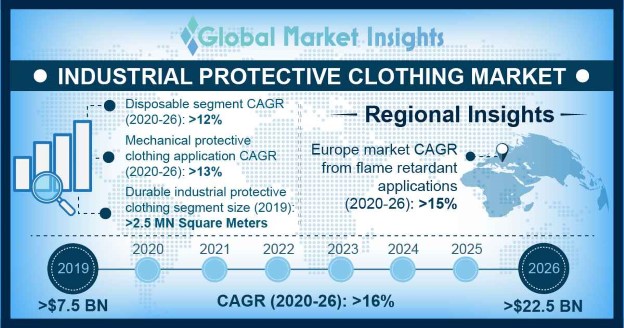Industrial Protective Clothing Market to witness heavy growth via strict worker safety norms worldwide
Publisher : Fractovia | Published Date : 2017-02-13Request Sample
Industrial Protective Clothing Market share is slated to grow substantially by the rising awareness regarding fatality occurrence in the accident-prone industries such as mechanical, chemical, oil & gas and construction. According to Global Market Insights, Inc., “Global Industrial Protective Clothing Market is estimated to register a CAGR of 14% over the period of 2016 to 2023.” Many of the worldwide organizations such as NIOSH, NFEA, and OSHA are imposing stringent rules and regulations about the working safety, which will in turn boost industrial protective clothing industry.
U.S Industrial Protective Clothing Market size, by application, 2015 & 2023 (USD million)

Flame-retardant apparels application is projected to witness a CAGR of more than 14% over the coming period of 2016-2023
The predominant applications of the industrial protective clothing industry are flame retardant apparels, clean room clothing, limited general-use clothing, chemical defending garments, and mechanical protective clothing. The mechanical protective clothing application segment will achieve a revenue of more than USD 2 billion by 2023, owing to the emergence of durable and light-weight products, which are extensively used for oil & gas and manufacturing industries. The flame-retardant apparels accounted for a revenue of over USD 1.3 billion in 2015 and will generate lucrative revenue over the coming years, driven by its huge demand across oil & gas petrochemical sectors. The flame retardants apparels are primarily used where risky operations are carried out such as grinding and welding across the foundries like metal forming & forging.
Disposable and Durable are the two major products of the industrial protective clothing. Below is the highlight of the product trend in industrial protective clothing industry over 2016-2023:
|
Product |
CAGR (2016-2023) |
Drivers |
|
Disposable industrial protective clothing |
13% |
Rising demand across low and medium level hazardous areas such as agriculture, pharmaceutical, tank cleaning, petrochemical, and chemical processing will boost the disposable industrial protective clothing market size. |
|
Durable industrial protective clothing |
14% |
Major risk-prone areas such as mines and oil rigs will augment the demand for durable industrial protective clothing significantly. The notable characteristics of the cloth like high utility, wear resistant, and durability will also influence the product demand. |
Regionally, MEA industrial protective clothing industry is anticipated to register a growth rate of over 10% over the coming six years, owing to the largest establishment of petrochemical industry across this region. The growing demand for chemical and flame retardant clothing across MEA will influence MEA industrial protective clothing market growth lucratively.
North America industrial protective clothing industry share occupied more than 40% of the global revenue and will grow noticeably over the coming years, driven by the strict safety regulations imposed by the organizations such as NFEA, OSHA, and NIOSH.
Asia Pacific industrial protective clothing market size is predicted to record a CAGR of 15% over the period of 2016 to 2023. The growing investment in the construction sector such as residential buildings, harbors, and airports across this region will augment the industry growth. India, Japan, and China will contribute significantly towards the regional demand.
The industry players will adopt the business strategies such as mergers, acquisitions, and collaboration to sustain the higher market position. The key players in the global industrial protective clothing market are Royal Ten Cate, DuPont, Honeywell, Teijin, Kimberly-Clark, Bulwark FR, Ansell, and W. L. Gore.